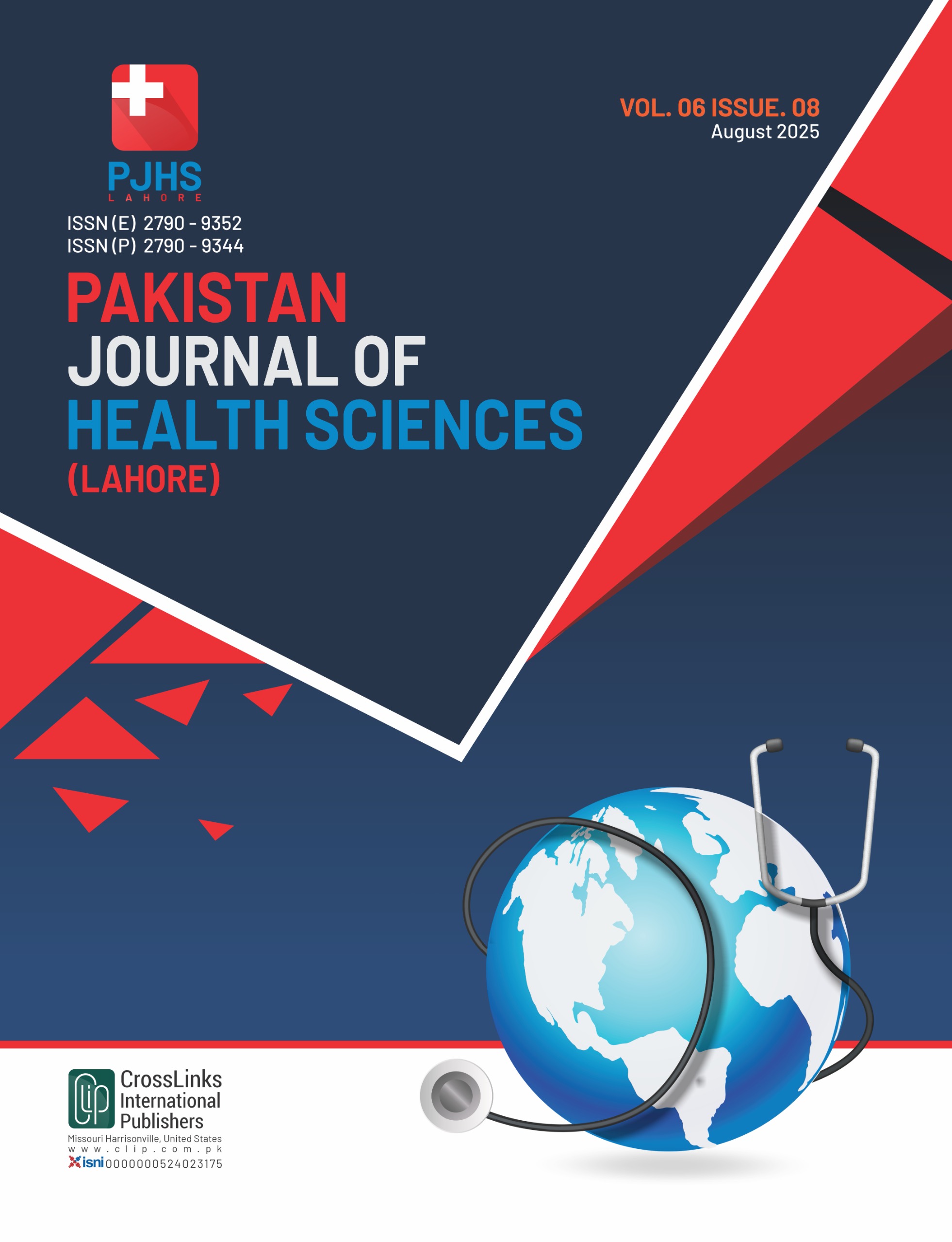Early Detection of Cardiovascular Risk in Pediatric Populations: Are We Doing Enough Compared to Adult Protocols?
Early Detection of Cardiovascular Risk in Pediatric Populations
DOI:
https://doi.org/10.54393/pjhs.v6i8.3177Keywords:
Cardiovascular Diseases, Dyslipidemias, Obesity, Pediatric Population, Risk FactorsAbstract
Cardiovascular diseases, once considered primarily adult health concerns, are increasingly being traced back to risk factors emerging during childhood. Objectives: To evaluate the early detection of cardiovascular risk factors in pediatric populations and compare current pediatric screening practices with established adult protocols in a low-resource setting. Methods: This was a cross-sectional analytical study conducted at the Department of Pediatric Cardiology, Quaid-e-Azam Medical College, Bahawalpur, from March 2024 to March 2025. A total of 341 children aged 5–12 years were enrolled using non-probability consecutive sampling. Data were collected through structured interviews, anthropometric measurements, blood pressure readings, and fasting laboratory investigations, including lipid profile, fasting blood glucose, HbA1c, and serum. Participants were stratified by BMI, lifestyle, and family history. Results: Obesity was observed in 8.2% of participants, and 27.3% had a waist-to-height ratio ≥0.5. Hypertension was identified in 27.0% of children and dyslipidemia in 38.7%. Low HDL (<45 mg/dL) was seen in 46.6%, and triglycerides ≥130 mg/dL in 38.7%. Vitamin D deficiency (<20 ng/mL) was found in 66.6%, with a significant inverse correlation with triglyceride levels (r=–0.41, p<0.001). Obesity (OR 3.67, 95% CI: 2.10–6.41, p< 0.001), sedentary lifestyle (OR 2.34, 95% CI: 1.33–4.12, p=0.004), and family history of CVD (OR 2.26, 95% CI: 1.30–3.95, p=0.003) were significant predictors. Conclusions: The high prevalence of early cardiovascular risk factors in Pakistani children highlights the urgent need for structured pediatric screening protocols.
References
Candelino M, Tagi VM, Chiarelli F. Cardiovascular Risk in Children: A Burden for Future Generations. Italian Journal of Pediatrics. 2022 Apr;48(1): 57. doi: 10.1186/s13052-022-01250-5. DOI: https://doi.org/10.1186/s13052-022-01250-5
Schipper HS and De Ferranti S. Cardiovascular Risk Assessment and Management for Pediatricians. Pediatrics. 2022 Dec;150(6): e2022057957. doi: 10.1542/peds.2022-057957. DOI: https://doi.org/10.1542/peds.2022-057957
Nuotio J, Laitinen TT, Magnussen CG, Sinaiko AR, Bazzano LA, Daniels SR, et al. Predictors of Adult Cardiovascular Events. Pediatrics. 2024 Nov;154(5): e2024066736. doi: 10.1542/peds.2024-066736. DOI: https://doi.org/10.1542/peds.2024-066736
Meng Y, Mynard JP, Smith KJ, Juonala M, Urbina EM, Niiranen T, et al. Pediatric Blood Pressure and Cardiovascular Health in Adulthood. Current Hypertension Reports. 2024 Nov; 26(11): 431-50. doi: 10.1007/s11906-024-01312-5. DOI: https://doi.org/10.1007/s11906-024-01312-5
Hanssen H and Hauser C. Childhood Risk Trajectories into Adulthood: Fit for Future? European Journal of Preventive Cardiology. 2025 Apr; zwaf249. doi: 10.1093/eurjpc/zwaf249. DOI: https://doi.org/10.1093/eurjpc/zwaf249
Bagkaki A, Parthenakis F, Chlouverakis G, Galanakis E, Germanakis I. Cardiovascular Disease Screening in Primary School Children. Children. 2024 Dec; 12(1): 38. doi: 10.3390/children12010038. DOI: https://doi.org/10.3390/children12010038
Shishehbori F and Awan Z. Enhancing Cardiovascular Disease Risk Prediction with Machine Learning Models. arXiv preprint arXiv:2401.17328. 2024 Jan.
Lu J, Brown SR, Liu S, Zhao S, Dong K, Bold D, et al. Early Risk Prediction of Pediatric Cardiac Arrest from Electronic Health Records via Multimodal Fused Transformer. arXiv preprint arXiv:2502.07158. 2025 Feb.
Khan K, Ullah F, Syed I, Ullah I. The Role of Machine Learning in Congenital Heart Disease Diagnosis: Datasets, Algorithms, and Insights. arXiv preprint arXiv:2501.04493. 2025 Jan.
De Ferranti SD, Steinberger J, Ameduri R, Baker A, Gooding H, Kelly AS, et al. Cardiovascular Risk Reduction in High-Risk Pediatric Patients: A Scientific Statement from the American Heart Association. Circulation. 2019 Mar; 139(13): e603-34. doi: 10.1161/CIR.0000000000000618. DOI: https://doi.org/10.1161/CIR.0000000000000618
Flynn JT, Kaelber DC, Baker-Smith CM, Blowey D, Carroll AE, Daniels SR, et al. Clinical Practice Guideline for Screening and Management of High Blood Pressure in Children and Adolescents. Pediatrics. 2017 Sep; 140(3). doi: 10.1542/peds.2017-1904. DOI: https://doi.org/10.1542/peds.2017-3035
Volpe M, Galiuto L. Detection of Risk Factors in Childhood: A New Perspective in Cardiovascular Prevention.
Jafari M, Shoeibi A, Ghassemi N, Heras J, Ling SH, Beheshti A, et al. Automatic Diagnosis of Myocarditis Disease in Cardiac MRI Modality Using Deep Transformers and Explainable Artificial Intelligence. arXiv preprint arXiv:2210.14611. 2022 Oct.
Chowdhury S, Jackson L, Byrne BJ, Bryant RM, Cade WT, Churchill TL, et al. Longitudinal Observational Study of Cardiac Outcome Risk Factor Prediction in Children, Adolescents, and Adults with Barth Syndrome. Pediatric Cardiology. 2022 Aug; 43(6): 1251-63. doi: 10.1007/s00246-022-02846-8. DOI: https://doi.org/10.1007/s00246-022-02846-8
Yasmin K. Cardiometabolic Risk Factors in South Asians: An Epidemiological and Anthropological Study in an Urban Populace of Eastern India. Medical Preprint Archive. 2024 Dec: 2024-12.https://doi.org/10.2139/ssrn.5042357. DOI: https://doi.org/10.2139/ssrn.5042357
Magnussen CG, Koskinen J, Chen W, Thomson R, Schmidt MD, Srinivasan SR, et al. Pediatric Metabolic Syndrome Predicts Adulthood Metabolic Syndrome, Subclinical Atherosclerosis, and Type 2 Diabetes Mellitus but Is No Better than Body Mass Index Alone: The Bogalusa Heart Study and the Cardiovascular Risk in Young Finns Study. Circulation. 2010 Oct; 122(16): 1604-11. doi: 10.1161/CIRCULATIONAHA.110.940809. DOI: https://doi.org/10.1161/CIRCULATIONAHA.110.940809
Daniels SR and Greer FR, Committee on Nutrition. Lipid Screening and Cardiovascular Health in Childhood. Pediatrics. 2008 Jul; 122(1): 198-208. doi: 10.1542/peds.2008-1349. DOI: https://doi.org/10.1542/peds.2008-1349
Dolezalova N, Reed AB, Despotovic A, Obika BD, Morelli D, Aral M, et al. Development of an Accessible 10-Year Digital Cardiovascular (DiCAVA) Risk Assessment: A UK Biobank Study. European Heart Journal-Digital Health. 2021 Sep; 2(3): 528-38. doi: 10.1093/ehjdh/ztab057. DOI: https://doi.org/10.1093/ehjdh/ztab057
Ahsan MM, Siddique Z. Machine Learning-Based Heart Disease Diagnosis: A Systematic Literature Review. Artificial Intelligence in Medicine. 2022 Jun; 128: 102289. doi: 10.1016/j.artmed.2022.102289. DOI: https://doi.org/10.1016/j.artmed.2022.102289
Xiang E, Wang T, Poddar V. High-Throughput Detection of Risk Factors to Sudden Cardiac Arrest in Youth Athletes: A Smartwatch-Based Screening Platform. arXiv preprint arXiv:2412.12118. 2024 Dec.
Downloads
Published
How to Cite
Issue
Section
License
Copyright (c) 2025 Pakistan Journal of Health Sciences

This work is licensed under a Creative Commons Attribution 4.0 International License.
This is an open-access journal and all the published articles / items are distributed under the terms of the Creative Commons Attribution License, which permits unrestricted use, distribution, and reproduction in any medium, provided the original author and source are credited. For comments













